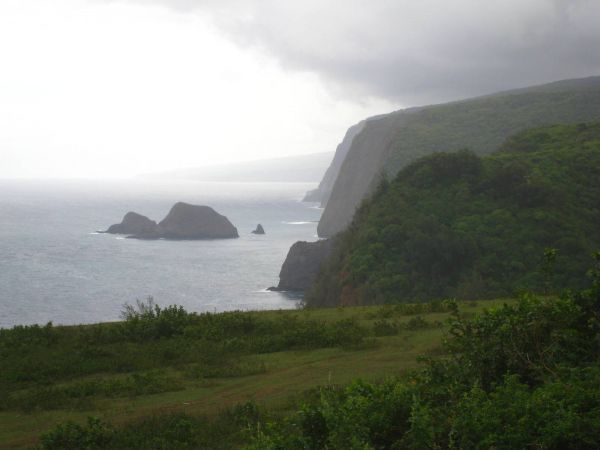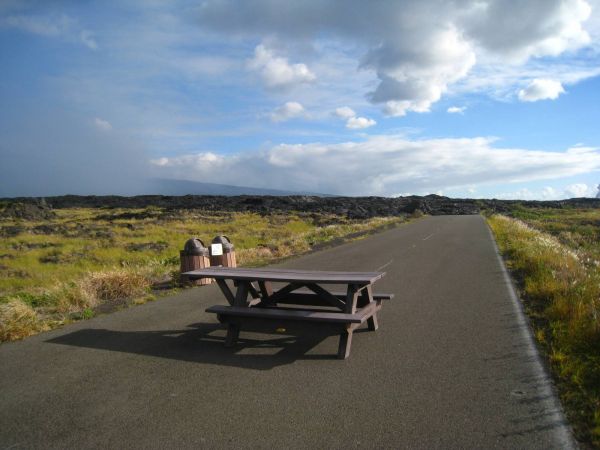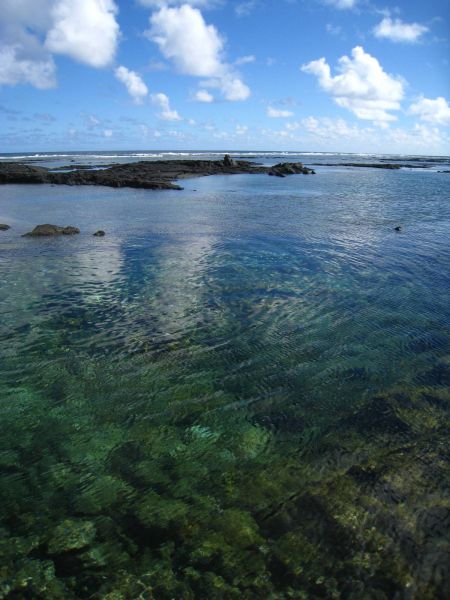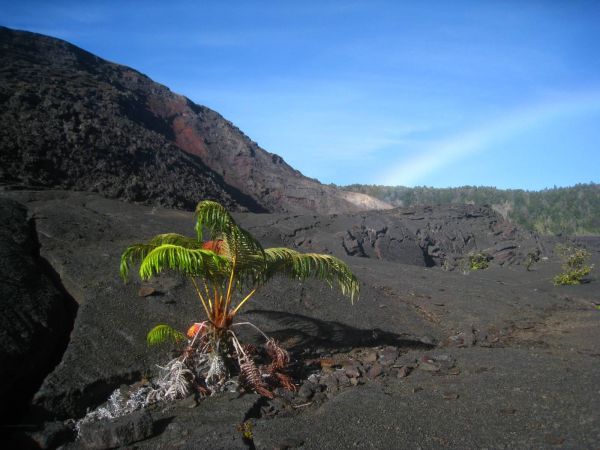
We leave the volcanoes to reach the coastal road. We want to cover the north and east side of the island hoping to discover paradisiac beaches or breathtaking viewpoints. Our Jeep navigates on the bituminous ribbon which juggles among beaches and cliffs. Within the cracks of the steep rock faces, the valleys squeeze a thick vegetation which glides towards the ocean. The northern Polulu valley competes with the southern Waipio valley. Our eyes get lost into the immensity of the landscapes and far down, when the water meets the stone, it dies into a white foam. We take again the road to venture hinterland for a couple of hours. The scenery changes so fast, here we are in the tropical forest. But our presence is not the fruit of chance, that's to encounter a few particles of suicidal water that makes a great leap from the top of a cliff, the Akaka falls.















Tuesday 4 November 2008
wide angle over Big Island
By dorian on Tuesday 4 November 2008, 09:16 - RTW2-Hawaii
Monday 3 November 2008
into the stars on the Mauna Kea
By dorian on Monday 3 November 2008, 08:31 - RTW2-Hawaii

Two 4000-meter-plus peaks, the Mauna Loa and the Mauna Kea, breakthrough the milk-white expanse of clouds which invariably covers the afternoons of Big Island. A road makes its way through the two giants, we travel it for several dozens of kilometers then turn off to the right and rise on the slopes of the Mauna Kea. The vegetation vanishes, a low-growing and crimson grass takes place and wraps the stone-free areas. We close our windows, the cold makes our skin tingle. But the temperatures aren't wintry yet when a layer of snow strews the heights of the volcano.
The purity of the sky attracts worldwide astronomers and a flock of white- or silvery-domed metallic mushrooms thrusts up on the top. These observatories and telescopes use the latest technologies to attempt to fathom out the stars and other luminous and radio-electrical manifestations. We park near the largest telescope in the world. The surrounding ocean of clouds doesn't take long to soak up ochre shades and we remain silent in front of the sun which slowly disappears on the horizon.
When the night is dark enough, halfway up the hill, a group of amateur or professional astronomers give us explanations about the starry vault. Electronically-controlled portable telescopes point at remarkable objects such as galaxies or cosmic clouds. An informal and educational encounter between a group of enthusiasts and a handful of tourist eager for understanding a little bit more of what happens overhead.










Sunday 2 November 2008
When the Kilauea volcano expresses itself
By dorian on Sunday 2 November 2008, 08:17 - RTW2-Hawaii
I change island to complete the kaleidoscope of discoveries of the Hawaiian archipelago. I get to the largest of them, the island of Hawaii. To avoid the mix-up with the archipelago or state name, it was rechristened without great originality, The Big Island. This emerged land is a mixture of superlatives, geological quirks and visual pleasures. Thinking that on an island hardly larger than Corsica, we can find the most active volcano in the world where its lava pours into the ocean for over 20 years increasing the area with more than 150 hectares and making of Big Island, the youngest land on earth; to that, another volcano, the Mauna Loa, is the tallest mountain in the world if we take into account its base nestled in the abyssal depths ; and to complete the list, on this volcanic outcrop, we can find 11 out of the 13 climatic areas which govern the planet, the largest telescope in the world, turtles that linger on black sand or even a green sand beach we can lay down a towel on...
I meet again my friend Cho and his girlfriend who have rented a Jeep Wrangler for these few days. Without waiting, we dash towards the volcanoes national park to eyewitness the damages caused by the Kilauea volcano, endlessly erupting from the middle of the 80's. The huge caldera where smokes leak from the bowels of the earth stretches a few steps away from the entrance. No sign of vegetation around, everything is charred. It's only in the background that ferns and scrub breakthrough the volcanic crust here and there. We take the road which goes down to the sea. Thousands of shrubs and bushes intertwine in a compact and impenetrable forest. But successive flows reshaped the local geography, such as a gigantic candle whose charcoal grey paraffin would have melted on the scenery. Down the valley, the road fades, the hardened lava covered the tar mac, we get off the car to step on this cracking ground, an end-of-the-world illusion where the Earth won the game against the human being.











In some places, the lava shaped tunnels it's possible to visit today. The approach blends in the surreal scenery, myriads of shrubby ferns flank the path. That's hardly believable to think that, about a hundred meters away, a desolate and still inapt for life land rises.






We get to the other side of the park to witness the current flow which merges with the ocean, freeing a thick smoke. But for that, we must skirt the volcano because the coast road was completely ravaged by the magmatic discharge of Kilauea. En route, still-protected areas let us catch a glimpse at the kind of vegetation which decorated the land before the lava buried this ephemeral beauty.










Before moving to another scenery, our last encounter with the volcanoes park will be a stroll within one of the calderas, the Kilauea Iki trail. An explanatory brochure makes us be aware that under this purportedly solid and stable ground, the heart is still hot and only 50 years ago, this flat and blackish expanse was bubbling in a lava lake. People got off luxury liners to enjoy it. The scientists saw an unheard-of opportunity to study the lava, the speed and way of how it solidified. We stay long minutes in the crater, a hint of supernatural for an extraordinary interlude in my traveler's life.












« previous entries - page 7 of 54 - next entries »









